
Finding a business that has the potential to grow substantially is not easy, but it is possible if we look at a few key financial metrics. Amongst other things, we'll want to see two things; firstly, a growing return on capital employed (ROCE) and secondly, an expansion in the company's amount of capital employed. Put simply, these types of businesses are compounding machines, meaning they are continually reinvesting their earnings at ever-higher rates of return. With that in mind, we've noticed some promising trends at Oyang (KRX:006090) so let's look a bit deeper.
Return On Capital Employed (ROCE): What Is It?
For those who don't know, ROCE is a measure of a company's yearly pre-tax profit (its return), relative to the capital employed in the business. The formula for this calculation on Oyang is:
Return on Capital Employed = Earnings Before Interest and Tax (EBIT) ÷ (Total Assets - Current Liabilities)
0.069 = ₩16b ÷ (₩350b - ₩118b) (Based on the trailing twelve months to March 2024).
So, Oyang has an ROCE of 6.9%. On its own that's a low return on capital but it's in line with the industry's average returns of 7.1%.
Check out our latest analysis for Oyang

Historical performance is a great place to start when researching a stock so above you can see the gauge for Oyang's ROCE against it's prior returns. If you're interested in investigating Oyang's past further, check out this free graph covering Oyang's past earnings, revenue and cash flow.
The Trend Of ROCE
Even though ROCE is still low in absolute terms, it's good to see it's heading in the right direction. The numbers show that in the last five years, the returns generated on capital employed have grown considerably to 6.9%. The company is effectively making more money per dollar of capital used, and it's worth noting that the amount of capital has increased too, by 27%. This can indicate that there's plenty of opportunities to invest capital internally and at ever higher rates, a combination that's common among multi-baggers.
The Key Takeaway
A company that is growing its returns on capital and can consistently reinvest in itself is a highly sought after trait, and that's what Oyang has. And investors seem to expect more of this going forward, since the stock has rewarded shareholders with a 45% return over the last five years. Therefore, we think it would be worth your time to check if these trends are going to continue.
One more thing to note, we've identified 3 warning signs with Oyang and understanding them should be part of your investment process.
If you want to search for solid companies with great earnings, check out this free list of companies with good balance sheets and impressive returns on equity.
New: AI Stock Screener & Alerts
Our new AI Stock Screener scans the market every day to uncover opportunities.
• Dividend Powerhouses (3%+ Yield)
• Undervalued Small Caps with Insider Buying
• High growth Tech and AI Companies
Or build your own from over 50 metrics.
Have feedback on this article? Concerned about the content? Get in touch with us directly. Alternatively, email editorial-team (at) simplywallst.com.
This article by Simply Wall St is general in nature. We provide commentary based on historical data and analyst forecasts only using an unbiased methodology and our articles are not intended to be financial advice. It does not constitute a recommendation to buy or sell any stock, and does not take account of your objectives, or your financial situation. We aim to bring you long-term focused analysis driven by fundamental data. Note that our analysis may not factor in the latest price-sensitive company announcements or qualitative material. Simply Wall St has no position in any stocks mentioned.
Have feedback on this article? Concerned about the content? Get in touch with us directly. Alternatively, email editorial-team@simplywallst.com
About KOSE:A006090
Oyang
Engages in deep-sea fishing, food, and rental business in South Korea and internationally.
Good value with mediocre balance sheet.
Market Insights
Community Narratives



